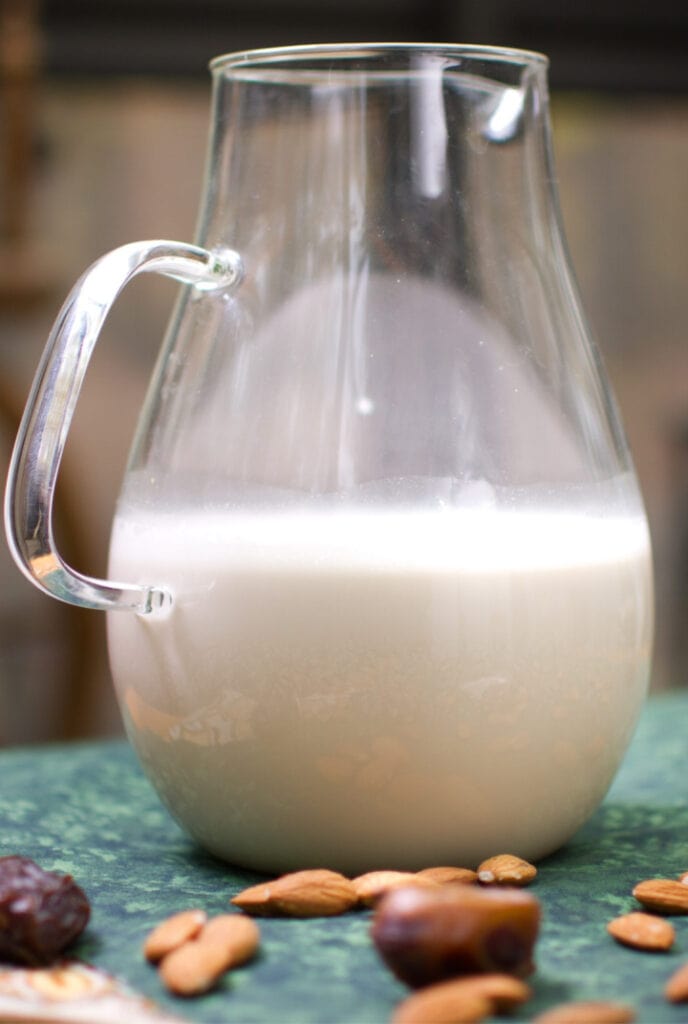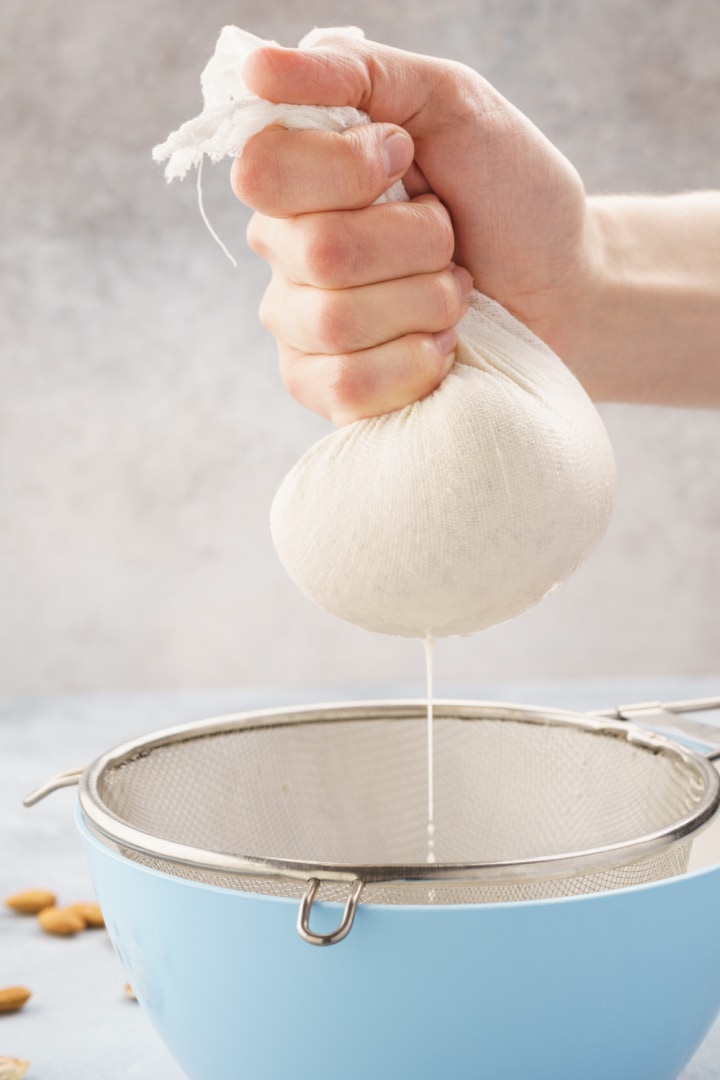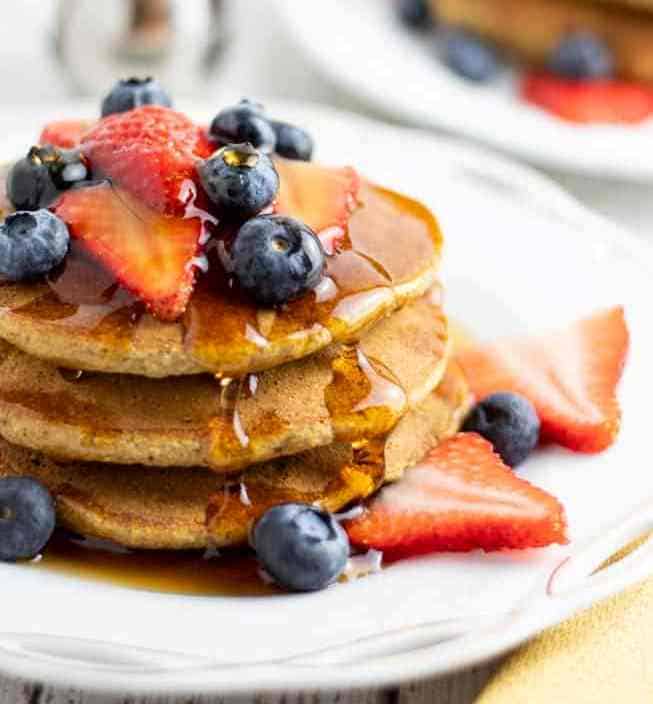Homemade Almond Milk
This recipe for homemade almond milk is simple and delicious, requiring just soaked almonds, water, and a bit of sweetness if desired. It’s incredibly fresh and free from additives, allowing you to control the flavor and sweetness to your liking.

Almond Milk is a perfect dairy-free milk option and is so easy to make right in your own kitchen in only about 10 minutes. This simple recipe is from the PlantPure Kitchen Cookbook by Kim Campbell.
This dairy-free milk substitute is terrific served with cereal and fresh fruit or used in any recipe that calls for milk as an ingredient. Recipe creator, Kim Campbell, uses it in her Blueberry Cornmeal Pancakes, and I like to make my Applesauce Muffins with it.
Some other great dairy-free milk options include Soy Milk and Cashew Milk, so be sure to give those a try as well.
Reasons you will love this recipe
- Fresh & Flavorful – Enjoy the rich, creamy taste of homemade almond milk, free from preservatives and artificial additives found in store-bought versions.
- Easy to Customize – Tailor your almond milk to your taste by adjusting the sweetness or adding flavors like vanilla or cocoa for a delightful twist.
- Nutritious & Wholesome – Packed with healthy fats, vitamins, and minerals, this almond milk is a nutritious option for smoothies, cereals, and baking.
Ingredients you will need
- Raw almonds- Great for making plant-based milk because they provide a naturally creamy texture and a mild, slightly sweet flavor that enhances the milk’s overall taste. Additionally, they are packed with healthy fats, protein, and essential nutrients, making the milk both nutritious and satisfying.
- Sweetener- Dates or maple syrup provides natural sweetness without the need for refined sugars, enhancing the flavor while keeping it wholesome. These natural sweeteners also add a hint of caramel or vanilla notes, making the milk even more delicious and enjoyable in smoothies or coffee.
Substitutions & Tips
- Soaking nuts- This recipe is much quicker if your blender is high-powered because it eliminates the need for soaking the nuts overnight.
- Straining- Though using almonds requires straining, using cashews instead may eliminate the need for straining because there will be a smaller amount of nut pulp.
- Sweetness- There is no need to add dates or maple syrup if you don’t desire sweeter milk.
- Options- For more vegan milk options, check out this list of Homemade Vegan Milks.
How to make almond milk
The recipe card at the bottom of the page has the full list of ingredients with measurements and instructions.

STEP #1: If you are using a standard blender that is not high-powered, you’ll need to soak the nuts in water overnight and then drain them. Personally, my blender is a Vitamix 5200 series, and that thing blends up almonds and anything else I toss into it.
STEP #2: Combine all the ingredients in a blender and process on high for 1 to 2 minutes, until completely smooth and creamy.

STEP #3: Strain the milk through a reusable nut milk bag. This ensures that your milk will be nice and smooth. Recipe creator, Kim Campbell, says there are a variety of bags to choose from, but she strongly recommends a larger size.

STEP #4: Use it immediately or chill it in the refrigerator before using it pour it over your breakfast cereal, add in smoothies, or coffee, or as a base for creamy soups and sauces.
Optional add-ins
This almond milk recipe tastes terrific just like it is, especially if you add in the optional dates to sweeten it up a little. If you want to switch it up a little more, consider adding in some of these.
- Vanilla- Adding vanilla to homemade almond milk enhances its flavor with a warm, aromatic sweetness that complements the natural nuttiness of the almonds. It elevates the overall taste, making the milk more enjoyable in recipes, smoothies, or on its own.
- Cocoa powder- Provides a rich, chocolatey flavor that transforms the milk into a delicious treat. It not only satisfies chocolate cravings but also adds antioxidants and a hint of natural sweetness, making it perfect for smoothies, hot chocolate, or as a flavorful addition to desserts.
- Fresh fruit- Adding strawberries or other fruits to homemade almond milk infuses it with a fresh, fruity flavor and a natural sweetness that enhances the overall taste.
What to do with the almond pulp
Don’t throw that pulp away! Believe it or not, the leftover almond pulp has a number of great uses.
- Almond meal- Easy-to-make almond meal can be used in your favorite baked goods.
- Topping- Bake in the oven at 200°F for about 2 hours until dry, then sprinkle over vegan desserts like Chocolate Tofu Mousse and Air Fryer Banana Boats.
- Wet ingredient– Add to recipes like Brownie Bliss Balls to add moisture and a vanilla-almond flavor.
Frequently Asked Questions
While you can skip the straining process, leaving the almond pulp in the milk will result in a thicker, grainier texture. You may want to blend the mixture again to achieve a smoother consistency if you choose not to strain.
Yes! Almond milk can be used in cooking and baking as a substitute for dairy milk in most recipes, including smoothies, soups, pancakes, and desserts.
Store the almond milk in a covered glass container in the refrigerator for up to 3-4 days. It might last a little longer if it’s kept in an airtight jar.
If it separates a little after a day or two, gently shake the jar or container until it is mixed back to consistency.
Almond milk has an impressive nutrient profile and is loaded with plenty of fiber, and antioxidants. That means that almond milk has a lot of health benefits and even contains bone-strengthening calcium and protein.
Since it’s dairy-free, there is no lactose, so almond milk won’t cause the digestive issues that many with lactose intolerance suffer from cow’s milk. Cashew Milk is another great vegan milk alternative.

If you try this recipe, please let us know how you like it by rating it and leaving a comment. We love to hear from you!
Want to Save This Recipe?
Enter your email & I’ll send it to your inbox. Plus, get great new recipes from me every week!
By submitting this form, you consent to receive emails from EatPlant-Based

Homemade Almond Milk
Ingredients
- 1 cup raw almonds or cashews
- 4 cups water
- 2 tablespoons sweetener such as pitted dates or maple syrup optional
Instructions
- If you are using a standard blender that is not high-powered, soak the nuts in water overnight and then drain them. Personally, my blender is a Vitamix 5200 series, and that thing blends up almonds and anything else I toss into it.
- Combine all the ingredients in a blender and process on high for 1 to 2 minutes, until completely smooth and creamy.
- Strain the milk through a reusable nut milk bag. This ensures that your milk will be nice and smooth. Recipe creator, Kim Campbell, says there are a variety of bags to choose from, but she strongly recommends a larger bag.
- Use it immediately or chill it in the refrigerator before using it pour it over your breakfast cereal, add in smoothies, or coffee, or as a base for creamy soups and sauces.
Video
Notes
- Straining- Though using almonds requires straining, using cashews instead may eliminate the need for straining because there will be a smaller amount of nut pulp.
- Soaking nuts- This recipe is much quicker if your blender is high-powered because it eliminates the need for soaking the nuts overnight.
- Sweetness- There is no need to add dates or maple syrup if you don’t desire sweeter milk.
- Almond meal- Easy-to-make almond meal can be used in your favorite baked goods.
- Topping- Bake in the oven at 200°F for about 2 hours until dry, then sprinkle over vegan desserts like Chocolate Mousse and Air Fryer Banana Boats.
- Wet ingredient– Add to recipes like Brownie Bliss Balls to add moisture and a vanilla-almond flavor.
Nutrition
Disclaimer
To obtain the most accurate representation of the nutritional information in a given recipe, you should calculate the nutritional information with the actual ingredients used in your recipe, using your preferred nutrition calculator. You are solely responsible for ensuring that any nutritional information provided is accurate, complete, and useful.
About the Chef
Kim Campbell is the author of the PlantPure Nation and the PlantPure Kitchen cookbooks. She developed more than 250 delicious whole-food plant-based recipes using no processed oils.
Kim is also the Director of Culinary Education and Development at PlantPure, where she works with her husband, Nelson, building an organization that promotes a whole foods plant-based diet. Nelson directed and produced the groundbreaking movie, PlantPure Nation.
Kim graduated from Cornell University with a BS in Human Service Studies with a concentration in Nutrition and Child Development. Her passion has always been nutrition education for children, families, and adults. Kim has been a plant-based cook for more than 25 years cooking for her family and friends. Her love of culinary goes back to her early childhood growing up in a large traditional family. Kim is gifted at creating traditional American cuisine using 100% accessible plant-based ingredients. She builds flavors and textures that are familiar to most people, helping to make the transition to a plant-based diet easier for people.
She is also the daughter-in-law of Dr. T. Colin Campbell, considered by many as the science ‘father’ of the rapidly growing plant-based nutrition movement.




